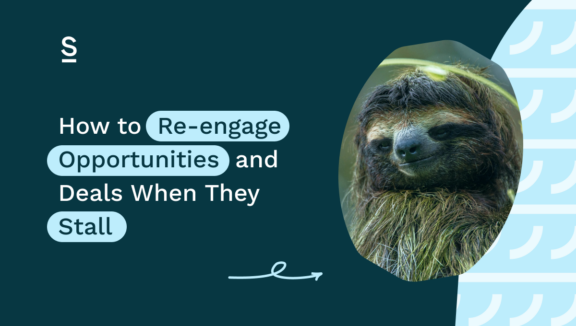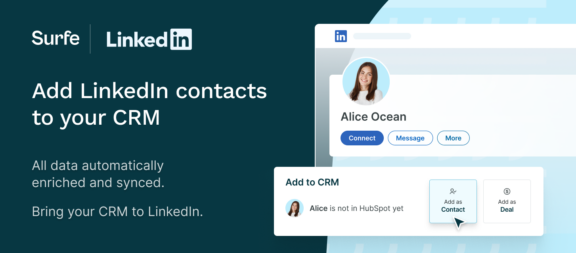How to Re-engage Opportunities and Deals When They Stall

What do sloths, lorises, and koala’s have in common?
Easy: they’re slow, and they’re cute.
What about a stalled sales deal or opportunity?
Slow, but not cute.
(Sorry to any prospects currently blocking deals. Not cute.)
In all seriousness, stalled deals are really not ideal for sales professionals. Our time is limited. Time spent on a deal that doesn’t close is time that could be spent on a deal that does close.
The less efficient you are, the less successful you’ll be. Plus, let’s be honest – unless you’re one of those LinkedIn-bro types that seems to thrive on punishing yourself – work is not that fun when it feels like a slog.
Problem solvers that we are, we’re here to talk about what you can do in the face of a stalled deal. You’ll come away from this blog post knowing how to re-engage an opportunity, and how to make sure it doesn’t stall in the first place.
Reading a blog post too slow for you? Skip ahead:
- Why do deals stall?
- How do you spot when a deal is stalling?
- How do you stop a deal from stalling in the first place?
- How do you re-engage a stalled deal?
- What tools can you use to re-engage opportunities?
Get your running shoes on. We’re off.

Why do deals stall?
“Everything happens for a reason” = a great turn of phrase to use in tough times. Stalled deals are no expectation. Things might have ground to a halt because:
- The decision-maker left
- The team structure changed
- Budgets were slashed
- Priorities shifted
- Another solution got their first
- You weren’t that important in the first place (sorry)
The main takeaway here is to expect the unexpected – because it’ll happen to you at some point.
Stalled deals and data: a match made in purgatory
So – the deal’s stalled. Maybe you know why, maybe you don’t. You’ve committed yourself to a stay in sales purgatory.
No.
This isn’t time to give up or rest on your laurels. Instead, it’s time to think about why this deal stalled. We’re not telling you to linger over your failures – we’re telling you to think about what’s gone wrong, and what you can learn from it.
Have you done a recce of the buyer’s journey and identified where they stalled? Have you noted it in the CRM? Compared it with similar situations?
Over time, this data’s going to be what gets you out of sales purgatory, and into sales heaven. We’ll talk about this in a minute – be patient.
How to spot when a deal is stalling
Ok, there’s the work you can do after a deal stalls. But how can you spot it – and stop it in its tracks?
Honestly, there’s not a magic formula here. And you can’t hassle your prospects for updates every minute of the day. The good news? It really comes down to what you’re good at already – sales.
Treat your prospects like people. Pay attention to them, and never stop reading the room. How did your pricing go down? Was there a question you couldn’t answer on the spot that seemed really important to them? Do they seem to be doing a u-turn after your last meeting, or have they been a bit uncertain from the start?
Gathering this data should inform your next move – and hopefully get the deal back on track.
How to stop a deal from stalling in the first place
First things first, the better your relationship is with your prospect, the less likely they are to stall. Nobody wants to let someone they like down – and this will lead to them doing more to get the rest of the deal across the line.
Some things are out of our control, though. If you’ve spotted a deal is stalling despite your best friend-making efforts, here’s what to do.
Identify the issue: you already know how to do this with your data analysis above.
Address the issue: do your best to solve the problem. For example:
- If it’s price, do you have any offers coming up? Do your marketing team have any content on ROI?
- If they need more information, what are they concerned about? Can you jump on a call or introduce them to the relevant SME within your business?
- If priorities are changing, do what you can to convince them now is the right time – but that said, make sure you’re working with their timelines rather than yours. If it’s not the right time, it’s not the right time.
It’s also really important to make sure all of the people in the buying committee have had their respective concerns addressed. The last thing you want is one individual stopping a deal because you’ve been too busy focussing on the person in front of you.
How to re-engage an opportunity?
So, for whatever reason you weren’t able to stop the deal from stalling. It’s on hold, you’ve done your research into why, and you’re feeling ready to give the prospect another go.
When to reach back out
This depends on why the deal stalled. If it’s because they decided to consider other options – do it sooner rather than later. You still have a seat at the table! If it’s because their budget’s been cut – you probably won’t get success until the new year or new financial year.
How to reach back out
A deal stalling isn’t a reason to forget all your principles. Remember: multi-touch, multi channel. In B2B sales, that means a mix of email, LinkedIn and phone.
Automation can ease the workload a little here – if you move the contact to a marketing nurture email list, for example – but you want to make sure they’re hearing from you personally too.
What to say
There is 0 benefit to beating around the bush here. Address the reason the deal stalled – talk about what went wrong and explain why the problem is no longer a problem (maybe your pricing has changed or you’ve spent a lot of time getting the problem member of the buying committee on board.
Remind them of what they loved about your product, and what got them interested in the first place. Once they’re engaged again, you want to try and close down the deal as soon as possible. Can you use a discount or a promotion? Introduce them to a member of your marketing team to discuss future collabs? Remember, the key here is not looking desperate but adding a little sweetener. Once they’re subconsciously thinking they have to reciprocate, you’re on the money.
What tools can you use to re-engage opportunities?
Great question. Give yourself a pat on the back.
Here’s the thing: re-engaging opportunities is hard. You’ll have to employ every ounce of wit, talent, and charisma you have to get things back on track. But you can use technology to give yourself a helping hand, too.
What we’d say here is that the most important thing is having everything tracked and up-to-date in your CRM. When the time comes to re-engage the deal, you need to have everything – and we mean everything – at your fingertips.
So, your CRM’s definitely one tool, sure. But how can you make sure everything you have in there is up-to-date?
Happily, we know someone that can help (and by that, we mean we can help).
Use Surfe to find contact data through LinkedIn – we use waterfall enrichment technology to find the most accurate email addresses and phone numbers – and it’ll automatically feed through to your CRM of choice.
The best part? All the data you find will be kept bang up to date thanks to the integration. For example, if your contact at the target business leaves you’ll know thanks to Surfe’s automatic contact data updates.
You can then hunt down their replacement and add the new contact to your CRM – complete with contact details – in just a couple of clicks. Surfe also keeps an eye on your LinkedIn message and InMail interactions, and pulls these through to your CRM too. Brilliant if you need a refresh on what happened and pointers on how best to open a new line of conversation.

Let’s wrap it up!
A stalled deal isn’t anyone’s idea of fun – but it doesn’t have to spell disaster. A patient, careful salesperson will be able to spot when a deal’s going wrong and do their best to get it back on track – or if not, learn from what happened and use that to re-engage, and win the deal. Bonus points if you then ask your prospect how their love life’s going, too.

Bring back deals from the dead with Surfe
You’re not going to recover a deal if you don’t have the contact data to do so. That’s where Surfe comes in – it uses LinkedIn to automatically find, migrate, and update contact data in your CRM. Pretty clever. Also, did we mention it’s free to try?
FAQs about re-engaging stalled opportunities and deals
What to do when a deal stalls?
When a deal stalls, try and find out what went wrong. Think back to when the process started to slow, and what the problem was. Once you’ve identified the problem, try and address it when you try to re-engage the prospect. For example, if they stall on price then the launch of a new offer is a perfect time to re-engage them.
Once you have got the deal back on track, try to close it quickly to avoid the same thing happening again, and to make sure your hard work doesn’t go to waste.
How to get a prospect re-engaged?
You should try and re-engage a prospect the same way you engaged them in the first place – using a multi-touch, multi-channel approach. In B2B sales, this usually means using a combination of LinkedIn, email and phone to approach your prospect. In your messaging, make sure you address the problem that stalled the deal in the first place. It’s also important not just to think about your key contact, but the people around them. Make sure every influencer has the opportunity to have their concerns answered.
How to re-engage cold leads?
You can use a combination of automated and manual outreach to re-engage your cold leads. Automated outreach could be adding them to a marketing newsletter for cold leads, or using message templates in LinkedIn and email to speed up getting in touch. Manual outreach examples include reaching out by phone, and making an effort to address the problems that stopped this particular deal going cold in the first place.
How to stop deals from stalling?
Make sure you pay attention during every interaction with a potential customer. If they seem very concerned with price, make sure to address concerns and provide additional content on ROI. If communications seem to slow down once you’ve had a meeting with another member of the buying committee, be sure to reach out to them and make sure they’re on board.
The most important thing is to be upfront and address any concerns or reasons for the deal stalling. If you know the reason, you can use this information to inform your next move.
How to get out of a stall?
If you need to get a deal moving again, first take the time to address the reason it stalled in the first place. Talk about the problem, and show them why it should no longer be a consideration.
Take the opportunity to remind your contact why they loved your product, and what got them interested in the first place. If you’re successful, make sure every influencer is on board and then see if you can hurry the deal along to a close. This doesn’t mean applying pressure or using pushy tactics, but instead trying to get your prospect to feel like they need to reciprocate – this could be giving a small discount or organising a meeting with an SME they’re curious to meet, for example.


